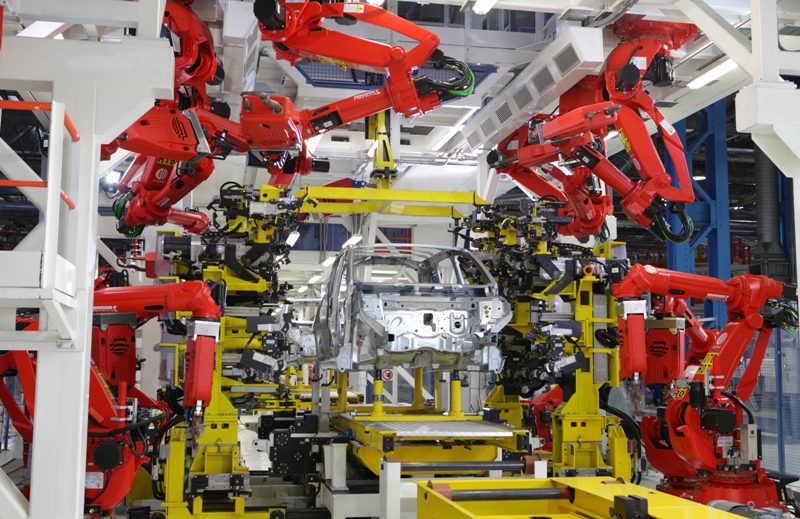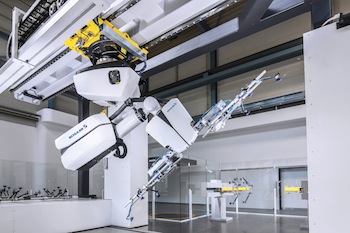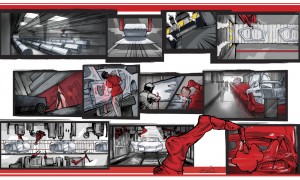Robots now play a key role in boosting quality, reliability and efficiency at automotive plants worldwide
Robot sales to the automotive sector have increased from 19,300 in 2009 to 69,400 in 2013, with China, Germany, the US and Japan the main takers. Indeed, a recent report by independent business information provider, Visiongain, estimates that automation and robotics in automotive manufacturing reached a value of approximately $13.66 billion in 2014. The growing uptake of robots is expected to continue in the coming years with increasing commitment from auto plants.
Volkswagen believes that robots could even hold the answer to Germany’s ageing workforce dilemma, which is looming out of the expected retirement of the baby-boom generation between 2015 and 2030 and a corresponding lack of young people able to take their place. Writing recently in Germany’s Sueddeutsche Zeitung, Horst Neumann, VW board member for human resources, said that some of the retiring baby-boomers’ jobs, typically those involving monotonous or non-ergonomic tasks, would be filled by robots rather than people. He said that robots cost VW about €5 ($5.67) an hour over the course of their lifetime, including maintenance and energy costs. That compares with about €40 an hour in labour costs per human, taking into account wages, pension and healthcare costs.
With these thoughts in mind, the rapid pace of robot development comes as no surprise, and technology vendors are using their latest innovations to leverage market share.
Rethinking production facilities
Italian robot specialist, Comau, is no exception. Comau Flex, for instance, is a standardised automated welding solution that is said to make it possible to rethink the layout of production facilities. It does this by integrating various units, such as sheet metal working and logistics units, with rapid installation and production start-up.
Using Fiat's World Class Manufacturing (WCM) standards, Comau Flex is based on two modular systems called VersaPallet and VersaRoll. The former is based on a high-speed, feed-roller conveyor which uses a skid to carry part of the chassis, as well as auto bodies at the end of the assembly process. VersaRoll is based on a carrier and a customised element conveyor called Antler, and is used during the car side processing phases. When combined, the modular systems are able to perform tasks that include assembly; resistance, arc and laser welding; and coating. The solution can be used to process aluminium in addition to steel, as in the case of the Jeep 520 manufactured at the Fiat Chrysler Automobiles (FCA) plant in Melfi, Italy.

The best example of product integration savings using Comau Flex is the welding machine, a Comau NJ4-90i robot with integrated welding gun – claimed to be the only such robot in the world. Thanks to the weight of the gun, which Comau says is 30kg lighter than competing products, it is possible to apply robots with a payload of less than 100kg on resistance welding applications.
In Italy, VersaRoll and VersaPallet lines have been installed within FCA plants at Cassino, Pomigliano and Melfi; 365 welding machines are operating at Pomigliano and 250 at Melfi. The latter produces one car every 53 seconds in random-mix production.
Comau Flex exemplifies a technology area that is currently abound with industry developments. For instance, 'machine vision' means that robots can now tackle jobs which previously proved daunting, such as processing castings that vary slightly in size, or a pile of connecting rods presented in a heap. Today, robots can adjust for discrepancies or randomly oriented parts using 2D and 3D camera technologies.
Schuler recently introduced its new generation of press automation equipment. The company’s Crossbar Robots are used to transfer parts from one stage of a press line to the next: removing up to four parts at a time from the die, changing their orientation where necessary, and placing them directly into the next die.
The new Crossbar Robot 4.0 can convey up to 15 parts per minute and is thus the fastest model yet. This is due to a modified drive system with two motors and a new transmission, as well as the halving of the robot’s weight. However, the maximum load (including tooling), remains unchanged at 90kg. Furthermore, thanks to an energy management system with integrated energy recovery, the energy efficiency has been improved by 20%.

Suitable for both new and existing press lines, a dual-action unit has been integrated into the IRB 6660 to create a seven-axis robot, which allows medium-size parts to be transferred rapidly along a linear path. As a result, vibrations created when parts are rotated 180° by a conventional six-axis robot are eliminated, says ABB.
A sensitive touch
Recent advances in tactile sensing also give robots the potential to adjust their motion in real time. ABB’s Integrated Force Control is among the technologies that claim to make it possible to assemble parts featuring tight tolerances without requiring ultra-precise and expensive fixtures. According to ABB, robots offering integrated force sensors can mimic the motions of a human arm to find the correct position to assemble a part. It does this with the help of feedback from a force sensor, allowing the robot to react to its surroundings in real time, adjusting its path and speed accordingly.
Another major current trend is collaborative robots, which work in close proximity to humans without the need for guards. While most large automotive plants are yet to move in this direction, the latest innovations may mean that this will soon change. For example, Kuka’s lightweight, seven-axis LBR iiwa (intelligent industrial work assistant), features sensory capabilities such as collision detection and integrated joint torque sensors in all axes for safety, fast teaching and simple operator control in ergonomically challenging tasks like inserting vehicle body plugs or screw fastenings in confined interiors. It is a compact system, and according to Kuka it is the only lightweight robot with a payload capacity of over 10kg, being available with payloads of up to 14kg.
“We want to step into the next robotics revolution,” says Christian Felkel, product manager at Kuka Roboter. “Our vision with LBR iiwa is firstly that we want to relieve workers at ergonomically poor workplaces. Secondly, we want to enable totally new assembly concepts, and thirdly we want to make possible the collaboration between robots and humans.”
Another automation supplier with a vested interest in this trend is Universal Robots. Late last year, the company unveiled the third generation of its UR5 and UR10 robot arms. With eight new adjustable safety rated functions, the company says these are the only robots in the world that adapt advanced safety settings to each specific application. The UR5 and UR10 robot arms (5kg and 10kg payload) also come equipped with true absolute encoders. Unlike many other industrial robots, these are not battery driven and therefore eliminate the need for reinitialising the robot, enabling automatic start-up and easier integration into other systems.
CTO of Universal Robots, Esben Østergaard, explains that the patented new safety concept is a logical development of the arms: “When a human enters the robot’s work cell, the robot arm can operate in reduced mode, and then resume full speed when he leaves. To achieve a switch between normal and reduced safety mode, eight functions are monitored by the new patented safety system: joint positions and speeds; TCP positions; orientation; speed and force; as well as the momentum and power of the robot. These settings can only be changed in a password-protected area.”
“Human-robot interactions can combine the ability to perform tasks requiring extreme repeatability and accuracy with the ability to think and problem solve”
– Esben Østergaard, Universal Robots
Ultimately of course, there is no industry standard definition of a ‘safe robot’. Making them lightweight and able to operate in reduced modes certainly helps, but common sense must still prevail. “We at Universal Robots take this discussion very seriously,” says Østergaard. “If our lightweight robots are to be deployed without extra safety equipment, a prior risk assessment is absolutely imperative. The UR5 and UR10 models are generally suitable for operation without a safety guard as they are always deployed in what is known as a collaborative mode, which is achieved by means of a force-limited function.” A test conducted in 2010 by the Danish Technological Institute (DTI) confirmed that, due to the permanent application of a force-limited function, the robot stops immediately whenever external forces of between 60 and 87N are applied to it.

Volkswagen’s Salzgitter engine plant is among the early adopters of technology from Universal Robots. Here, a lightweight UR5 robot is installed in the cylinder head assembly section, where it is responsible for handling delicate glow plugs. Due to its integrated safety mode, the six-axis robotic arm is able to interact directly with people in the absence of guards. The robot features a collaborative gripper developed for the application by system integrator, Faude. The robot carefully picks up the delicate glow plugs and puts them into hard-to-reach drill holes. An operator is then responsible for tightening the glow plugs.
The need for speed
While safety is a huge topic in robot-human assembly operations, back on the welding lines it is speed which continues to top the wish list. With this in mind, Yaskawa recently unveiled its new, high-speed MS165 and MS210 robots, which are 20% faster than previous ES-series robots in spot welding applications. The use of a gas spring and Yaskawa’s Sigma-5 motor technology result in a lighter weight and a reduced-profile design to allow higher robot density around a car body or a smaller work cell for tier one applications. The MS-series also includes the new MS100 and MS80W II robot models, which are designed to take advantage of lighter weight MFDC (mid-frequency direct current) spot guns. These compact arms are up to 30% faster than conventional robots, says Yaskawa.
Also for welding operations, Cloos has introduced its Qirox All-In-One series of compact robot systems. Qirox All-In-One means that the workpiece positioner, robot and robot positioner become one (mounted and aligned on a base plate). This allows quick and cost-effective installation because fine adjustment is not necessary, while the electrics and mechanics for the systems are pre-installed. According to Cloos, the All-In-One delivers on accessibility because better welding positions can be reached. Furthermore, the modular design allows individual extensions and retrofits at any time.
Regardless of the application, it seems that someone, somewhere is developing a new robot to make the operation quicker, more precise, more flexible or safer than ever before. With this in mind, discerning automotive manufacturing engineers must stay abreast of the latest developments to maintain a competitive edge.
 Tesla commissioned an artist to depict its EV manufacturing process as a comic
Tesla commissioned an artist to depict its EV manufacturing process as a comicThe most dramatic changes resulting from the facility upgrade are to be found in general assembly, where the company has replaced numerous overhead steel and mechanical structures in favour of robots that can lift and manoeuvre entire cars with optimum precision while taking up less space. Soon, the new robots will even be able to install battery packs in the cars, relieving humans of the most labour-intensive operation in the factory and reducing installation time from four to two minutes.
To celebrate this transformation, Tesla commissioned an artist to vist the plant and depict the manufacturing process in comic illustrations which have now been printed on the glass walls enclosing some of the robots.



































